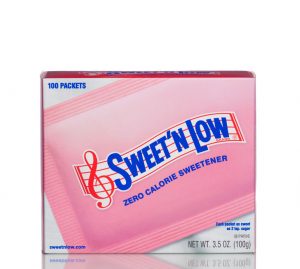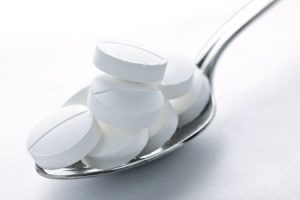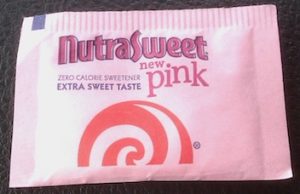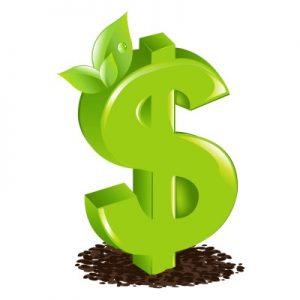
Do you use the pink packet, the blue or the yellow packet for a sweetener? Well, pick the pink pack if you insist on using an artificial sweetener.
The real winner in this sweetener war is the one who doesn’t use any of them at all, but if you still zip open a sweetener packet, or know someone who does, the pink is your better choice.
It never mattered to the manufacturer, though, because the same company owned both the pink and the blue. Pink or blue – Monsanto Chemical Company was winning your dollar for decades.
History shows that saccharin, the pink stuff known as Sweet ‘N Low®, was always safe for human use – it’s been safe for people all over the globe for a long time.
I’m not promoting using artificial sweeteners, at all, but it’s important to learn that the cancer warning was a marketing ploy to push NutraSweet® into the world market.
The pink stuff, saccharin, has never been proven to cause cancer in humans after over 100 years of use. To date, saccharin has only received a total of six (6) FDA complaints; whereas aspartame, found in the blue packet known as Equal®, received over 10,000 FDA complaints after the first ten (10) years it had been on the market.
This nightmare started in the 1960s. Aspartame had been proven in laboratory studies to eat holes in the brains of the laboratory animals. Yep, you read that right … aspartame ate holes in the brains of the laboratory animals.
Lab studies also showed aspartame caused malignant mammary gland and testes tumors, lower fetal IQ and fetal deformation. Yet it never had a danger warning other than for Phenylketonuria, the inherited inability to process the amino acid phenylalanine.
Why Demonize Saccharin And Not Aspartame?
So why then is the pink pack labeled a carcinogen and the blue pack deemed as safe when it’s actually the other way around?
I always wondered why the same company making saccharin and aspartame never defended its safety knowing the claim was false. Keeping the truth silent that saccharin never caused cancer was merely a marketing “set-up.”
Saccharin’s history will answer this question for you, too.
All About Saccharin
Saccharin was sold as Monsanto Chemical Company’s very first product in 1901. What most people do not know is that saccharin was coming out of China during WWII.
A fact search shows that saccharin was derived from coal in the lab in the late 1800s, but my father told me years ago that it was brought into India from China for the US Troops during WWII. Daddy knew in the 1940s that it was perfectly safe.
Hum.
Saccharin didn’t come on the market because it was a great alternative for weight loss or diabetes – it was a sugar substitute used because there was a sugar shortage in Europe during the war.
Again it was perfectly safe.
Monsanto
As a growing new company, Monsanto first established a deep-rooted business relationship with the soft drink industry through its manufacturing of saccharin.
After 30 years in the pharmaceutical industry, founder John Francis Queeny, an employee of Meyer Brothers Drug Company at the time, sank his savings and borrowed money from a Chicago soft drink supplier to invest in his new company to produce products for the food and pharmaceutical industries. He named the company after his wife, whose maiden name was Olga Monsanto.
1901

The corporate papers were filed on Nov. 29, 1901.
In 1902, Monsanto gained a respectable reputation manufacturing saccharin, the company’s first product. From 1903 to 1905, their entire saccharin output was shipped to the growing soft drink company in Georgia called Coca-Cola®.
It appears that saccharin was one of the secret ingredients in original Coca Cola.
Coca Cola
By 1904, Monsanto introduced caffeine and vanillin as products for the escalating soft drink industry. Initially, vanillin was produced by extracting a chemical from cloves that were purchased from the Sultan of Zanzibar who insisted that the left over spices be returned to him.
Cloves had an important religious significance in the cremation of bodies; hence, the importance of shipping them back to Zanzibar instead of disposing of them as waste in the United States.

Aspirin
As of 1915, Monsanto’s sales surpassed the $1 million mark. Two years later, the company began the production of aspirin. Monsanto remained the largest U.S. producer of aspirin until the 1980s.
A very interesting fact, in 1917, the U.S. government filed suit over the safety of saccharin as a test case at Monsanto’s request. The suit was dismissed in 1925, ending the government’s unsuccessful attempts to prove saccharin as harmful.
Saccharin And Cancer
In 1981, saccharin was again questioned as a carcinogen, but no conclusive scientific proof was ever presented. In 2001, the cancer warning was removed from saccharin product labels as saccharin was shown, once again, to be safe for human consumption – saccharin had never been proven to cause cancer in humans. As I write in my books, this agreement to lift the cancer warning in 2001 was first agreed upon in 1981.
The laboratory study proving saccharin caused bladder cancer in laboratory rats was false, and is now questioned as unethical modus operandi.
Saccharin VS NutraSweet

In 1981, Monsanto Chemical Co. finally succeeded in getting the U.S. Food and Drug Administration (FDA) to approve NutraSweet (aspartame) after their second approval attempt, taking the company deeper into pharmaceuticals and the sweetener industry. NutraSweet/Equal®, saccharin’s new competitor, was now owned and marketed by the same company – Monsanto.
So, here is the answer why the saccharin manufacturers didn’t cry foul and fight back when they “engineered” the cancer label on saccharin.
Monsanto owned them both, and decisions were made to sacrifice saccharin for NutraSweet, but just in case aspartame failed to bring in more money than saccharin (saccharin had failed in products like Tab® and Fresca®), they did not want to take saccharin completely off the market.
They left their options open.

Big Bucks
When Monsanto sold its sweetener business in 2000, including the NutraSweet brand sweetener division, the sale brought Monsanto $440 million.
Today, saccharin is now sold without the cancer warning and has been reintroduced into food products and colas.
Because of its health history, I recommend using saccharin over aspartame or Splenda. If you insist on zipping open a sweetener packet on a restaurant tabletop, choose the pink packet over the blue or yellow.
Natural sugars such as Sucanat® and stevia are preferable over saccharin, of course, but my point is that the research shows saccharin has less harmful side effects than the other more popular manufactured artificial sweeteners.
Why Saccharin Is A Better Choice
Saccharin does not completely digest in your body and its by-products are, therefore, less harmful than aspartame or Splenda. As I write in more detail in my books, aspartame breaks down into formaldehyde and Splenda’s sucralose breaks down into chlorine.
In our modern society where diabetes and obesity are now epidemic, we must all be prudent when selecting sugar substitutes, especially if you use them daily.
Before you try a new product – any product – research the natural alternative options and avoid all man-made chemicals in your diet.
The real winner in this sweetener war is the one who doesn’t use any of them at all.

_________________
If you want to learn more about the artificial sweeteners, Join my Private Inner Circle. I have written all about the sugar alcohols in my books on the diet sweeteners.
Gain access to all of my online programs, ongoing support, monthly Q&A, and more by joining my Private Inner Circle Membership Program. I look forward to supporting you on your journey to alternative health and wellness.
_____________
Disclaimer: This article is for informational purposes only, and is educational in nature. The FDA may not have evaluated some of the statements. This article is not intended to diagnose, treat, cure, or prevent any disease. Please discuss with your own, qualified health care provider before adding supplements or making any changes to your dietary program.
Before taking vitamins, consult your doctor; pre-existing medical conditions or medications you are taking can affect how your body responds to multivitamins.